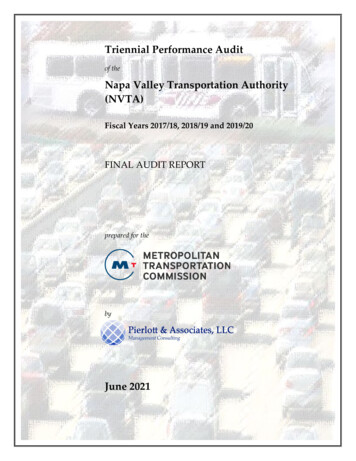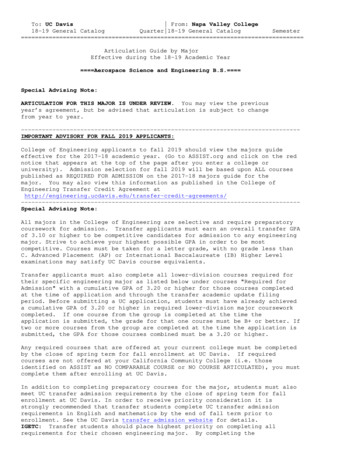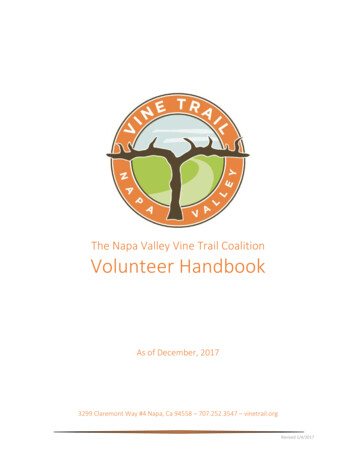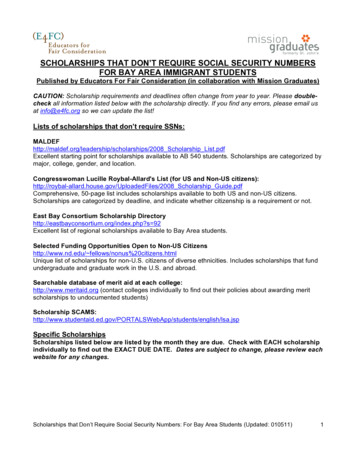
Transcription
Triennial Performance Auditof theNapa Valley Transportation Authority(NVTA)Fiscal Years 2017/18, 2018/19 and 2019/20FINAL AUDIT REPORTprepared for thebyJune 2021
NOTE:All exhibits in this report are presented at the end of theassociated discussion in each section.
EXECUTIVE SUMMARYThis executive summary highlights the findings from the performance audit of theNapa Valley Transportation Authority (NVTA). In California, a performance audit mustbe conducted every three years of any transit operator receiving TransportationDevelopment Act (TDA) Article 4 funds, to determine whether the operator is incompliance with certain statutory and regulatory requirements, and to assess theefficiency and effectiveness of the operator’s services. The two service modes operatedby NVTA Transit, bus and paratransit, are the prime focus of this performance audit. Theaudit period is Fiscal Years 2018 through 2020 (from July 1, 2017 through June 30, 2020).NOTE: Due to the COVID-19 emergency it is recognized that performance in the latterpart of FY2020 is anomalous with the earlier part of the audit period. As such, trendanalyses in this report do not place much emphasis on performance beyond FY2019 forthe purposes of drawing conclusions and formulating recommendations.Performance Audit and Report OrganizationThe performance audit was conducted for MTC in accordance with its establishedprocedures for performance audits. The final audit report consists of these sections: An assessment of data collection and reporting procedures; A review of performance trends in TDA-mandated indicators andcomponent costs; A review of compliance with selected PUC requirements; An evaluation of NVTA Transit’s actionsrecommendations from the last performance audit; An evaluation of functional performance indicator trends; andFinal Audit Report- ii -toimplementtheTriennial Performance Audit of NVTA
Findings, conclusions, and recommendations to further improve NVTATransit’s performance based on the results of the previous sections.Comments received from NVTA Transit and MTC staff regarding the draft reportwill be incorporated into the final report. Highlights from the key activities are presentedin this executive summary.Results and ConclusionsReview of TDA Data Collection and Reporting Methods - NVTA is in compliancewith the data collection and reporting requirements for the TDA statistics. In addition,the statistics collected over the six-year review period appear to be consistent with theTDA definitions, and indicate general consistency in terms of the direction andmagnitude of the year-to-year changes across the statistics.Performance Indicators and Trends – NVTA’s performance trends for the fiveTDA-mandated indicators were analyzed by mode. A six-year analysis period was usedfor all the indicators. In addition, component operating costs were analyzed. Bus Service – The following is a brief summary of the TDA performancetrend highlights over the six-year period of FY2015 through FY2020:‒The trend in operating cost per hour rose steadily throughout mostof the analysis period, increasing an average of 5.2 percent per yearin actual dollars and 2.3 percent in inflation-adjusted dollars.‒Passenger productivity exhibited steadily declining trends, withpassengers per hour decreasing an average of 1.5 percent per year,and passengers per mile decreasing an average of 1.9 percent peryear.Final Audit Report- iii -Triennial Performance Audit of NVTA
‒Over the six-year analysis period, cost per passenger increased anaverage of 6.8 percent annually in actual dollars and 3.8 percent ininflation-adjusted dollars.The following is a brief summary of the component operating costs trendhighlights for the bus service between FY2015 through FY2020: ‒Purchased transportation costs increased in nearly every year of theanalysis period, but were held to an average of less than four percentper year.‒Service costs exhibited significant increases in FY2020, however,these costs represent only about two to three percent of totaloperating costs.‒Materials and supplies, the second largest cost category, exhibitedup and down annual changes that resulted in an average annualchange of less than one percent.‒Other expenses rose sharply in FY2020, but still only comprised 2.5percent of total operating costs.Paratransit – The following is a brief summary of the TDA performancetrend highlights over the six-year period of FY2015 through FY2020:‒Paratransit cost per hour increased an average of 1.6 percent per yearover the six years in actual terms, but exhibited a 1.2 percent decreasein constant, inflation-adjusted terms.‒Passenger productivity generally remained steady through most ofthe analysis period, but declined in FY2020 as a result of thepandemic impacts on ridership.‒Cost per passenger rose slowly and steadily through the six-yearperiod posting an average increase of 7.2 percent per year in actualterms and a 4.3 percent per year increase in inflation-adjusted terms.The following is a brief summary of the component operating costs trendhighlights for paratransit between FY2015 through FY2020:Final Audit Report- iv -Triennial Performance Audit of NVTA
‒Purchased transportation costs represented by far the largest portionof the total costs, ranging between 84 and 88 percent during thereview period, and increased moderately an average 1.2 percent peryear.‒While representing a relatively small portion of total operating costs,both in-house labor and fringe benefits costs decreased over the sixyear period.‒Despite large swings , material and supplies costs remained virtuallyunchanged over the review period.Compliance with Statutory Requirements – NVTA is in compliance with thesections of the state PUC that were reviewed as part of this performance audit. Thesesections included requirements concerning CHP terminal safety inspections, laborcontracts, reduced fares, Welfare-to-Work, revenue sharing, and evaluating passengerneeds.Status of Prior Audit Recommendations – As a result of the prior audit, tworecommendations were offered. First, it was recommended that NVTA and its contractorshould expand efforts toward improving on-time performance across its services.Second, it was recommended that NVTA develop strategies to address a rise in theaccident rate by improving operator training and enhancing monitoring activities toensure that safety issues are identified and corrected.The prior audit found that schedule adherence on NVTA’s bus system remainedin a range of 76 to 78 percent. At the same time, paratransit schedule adherence decreasedfrom 77 percent in FY2015 to 75 percent in FY2017. In order to provide more reliableservice, it was recommended that NVTA and its contractor expand efforts towardimproving on-time performance across its services. While paratransit on-timeFinal Audit Report-v-Triennial Performance Audit of NVTA
performance has greatly improved, bus service on-time performance remainsproblematic due to inaccuracies of data collected by NVTA’s aging CAD/AVLequipment. The implementation of this recommendation is still in progress, and has beencarried forward into this audit.The prior audit recommendation related to the bus and paratransit accident rateshas been closed.Functional Performance Indicator Trends - To further assess NVTA’s performanceover the past three years, a detailed set of systemwide and modal functional areaperformance indicators was defined and reviewed. Systemwide (All Modes) – The following is a brief summary of thesystemwide functional trend highlights between FY2018 and FY2020:–Administrative costs remained fairly steady in terms of percentageof total operating costs (about 18 to 19 percent) and administrativecosts per vehicle service hour (about 18 per hour).–Revenue recovery exhibited a downward trend during the first twoyears of the audit period, which was exacerbated by the suspensionof fare collection due to the COVID public health emergency.Bus Service – The following is a brief summary of the bus service functionaltrend highlights between FY2018 and FY2020:‒Final Audit ReportService Planning results generally showed consistent performance interms of in-service miles and hours, as well as in passengerproductivity between FY2018 and FY2019. Performance in FY2020for these measures was negatively impacted as a result of thepandemic response.- vi -Triennial Performance Audit of NVTA
‒Operations results showed steady performance throughout the auditperiod in terms of vehicle operations costs as a percentage of totaloperating cost. Schedule adherence remained at a relatively lowlevel with performance between 66 and 68 percent of trips on-time.‒Maintenance costs were steadily at 12 percent of total operatingcosts. There was substantial improvement in the rate of majormechanical failures over the audit period for both major failures andall failures.‒The rate of preventable accidents remained consistent withperformance observed in the prior audit period.Paratransit – The following is a brief summary of the paratransit functionaltrend highlights between FY2018 and FY2020:‒Service Planning results showed steady performance in terms of inservice miles and hours operated as a percentage of total miles andhours. Despite ridership losses due to the pandemic emergency,passenger productivity exhibited only modest decreases.‒Operations results showed steady performance in terms of vehicleoperations costs as a percentage of total operating costs. Vehicleoperations cost per hour improved by 5.5 percent overall. Scheduleadherence remained consistent high throughout the audit period,and the rates of complaints improved by more than half.No ADA trip denials were reported during the entire audit period.While trip cancellation rates remained steady, the percentage of totaland late cancellation appears unusually high at 30 percent and 10percent, respectively. In addition, the no-show rate also appeared tobe unusually high, between seven and eight percent in FY2018 andFY2019, respectively, an increasing to nine percent in FY2020.‒Final Audit ReportMaintenance performance results exhibited improvementthroughout the audit period in terms of maintenance costs as apercentage of total costs, and maintenance costs per vehicle mile.Although the trend in service reliability (i.e., mean distance between-vii-Triennial Performance Audit of NVTA
failure) was downward, the actual number of failure in each yearwas rather low.‒While the trend in preventable accidents per 100,000 miles increased,there was only one accident per year in FY2018 and FY2019, and onlytwo in FY2020.Recommendations1.CONTINUE TO MONITOR SCHEDULE ADHERENCE ON THE BUS SERVICEAND DEVELOP STRATEGIES FOR IMPROVEMENT.[Reference Section: V. Status of Prior Audit Recommendations; VI. FunctionalPerformance Indicator Trends]The prior audit period found that schedule adherence on NVTA’s bus systemranged from 76 percent to 78 percent.In response to this performance, arecommendation was made to expand efforts toward improving on-timeperformance, including additional monitoring activities to identify the causes ofservice delays, and a plan for addressing the circumstances found that arehindering on-time operations. Through its monitoring efforts, NVTA concludedthat the bus on-time performance from its CAD/AVL system is not providingaccurate information. NVTA noted that the current CAD/AVL system nearlyseven years old and approaching the end of its useful life. The current system usesa communication threshold of 60 seconds, whereas new systems have thresholdsof every ten seconds. As such, vehicle positioning may not always be as accurateas it could be. Furthermore, discrepancies between the scheduled locations andthe location and size of the trigger boxes that surround the stops appear to begenerating errors in reporting the actual location of vehicles.Final Audit Report-viii-Triennial Performance Audit of NVTA
Bus service on-time performance worsened during this audit period with resultsbetween 66 percent and 68 percent. NVTA reported that they have issued an RFPfor a new CAD/AVL system to replace the existing system, and anticipates that thenew system will be in place sometime during 2021. Once the system is in place,NVTA should continue reporting its on-time performance to MTC to ensure thatthe new system and monitoring procedures are recording accurate information.Should bus on-time performance continue to be at the same level, NVTA shoulddevelop strategies to leverage the new technology to improve schedule adherence.2.TAKE STEPS TO REDUCE THE HIGH RATES OF TRIP CANCELLATIONS,LATE CANCELLATIONS, AND NO-SHOWS ON THE PARATRANSITSERVICE.[Reference Section: VI. Functional Performance Indicator Trends]Trip cancellations and late cancellations on NVTA’s paratransit service areconsistently around 30 percent and 10 percent, respectively. Furthermore, the rateof no-shows not only is unusually high, but increased from 7.2 percent to9.0 percent over the audit period.NVTA should examine the reasons for the large number of cancellations, latecancellations, and no-shows to determine how policies and procedures can bemodified to reduce their number.Final Audit Report- ix -Triennial Performance Audit of NVTA
Table of ContentsPage No.Executive Summary . iiPerformance Audit and Report Organization . iiResults and Conclusions . iiiRecommendations . viiiI. Introduction . 1Performance Audit and Report Organization .2II. Review of TDA Data Collection and Reporting Methods . 8Compliance with Requirements .8Consistency of the Reported Statistics.9III. TDA Performance Indicators and Trends . 14Bus Service Performance Trends .15Bus Service Component Costs .22Paratransit Performance Trends .26Paratransit Component Costs .32IV. Compliance with PUC Requirements . 36V. Status of Prior Audit Recommendations . 40VI. Functional Performance Indicator Trends . 43Systemwide .44Bus Service .47Paratransit .52VII. Conclusions and Recommendations . 57Appendix A: Input Statistics for Functional Performance Measures . A-1Functional Performance Inputs - Systemwide (All Modes) . A-2Functional Performance Inputs – Bus Service . A-3Functional Performance Inputs – Paratransit . A-4
List of ExhibitsPage No.Exhibit 1: System Overview . 3Exhibit 2.1: Audit Period Organization Chart . 6Exhibit 2.2: Current Organization Chart . 7Exhibit 3.1: Compliance with TDA Data Collection and Reporting Requirements . 10Exhibit 3.2: TDA Statistics – Bus Service . 12Exhibit 3.3: TDA Statistics – Paratransit . 13Exhibit 4: TDA Indicator Performance - Bus Service . 18Exhibit 4.1: Operating Cost per Vehicle Service Hour - Bus Service . 19Exhibit 4.2: Passengers per Hour and per Mile – Bus Service . 20Exhibit 4.3: Operating Cost per Passenger – Bus Service . 21Exhibit 4.4: Component Cost Trends – Bus Service . 24Exhibit 4.5: Distribution of Component Costs – Bus Service . 25Exhibit 5: TDA Indicator Performance – Paratransit . 28Exhibit 5.1: Operating Cost per Vehicle Service Hour – Paratransit . 29Exhibit 5.2: Passengers per Hour and per Mile – Paratransit . 30Exhibit 5.3: Operating Cost per Passenger – Paratransit . 31Exhibit 5.4: Component Costs Trends – Paratransit . 34Exhibit 5.5: Distribution of Component Costs – Paratransit . 35Exhibit 6: Compliance with State PUC Requirements . 37Exhibit 7: Status of Prior Audit Recommendations. 42Exhibit 8: Functional Performance Trends – Systemwide . 46Exhibit 9: Functional Performance Trends – Bus Service . 50Exhibit 10: Functional Performance Trends – Paratransit . 55
I. INTRODUCTIONPublic Utilities Code (PUC) Section 99246 requires that a performance audit beconducted every three years of each public transit operator in California. The auditrequirement pertains to recipients of Transportation Development Act (TDA) funds, andis intended to assure that the funds are being used efficiently. The substance and processof the performance audit is defined by the Regional Transportation Planning Agency(RTPA).In the San Francisco Bay Area, the Metropolitan Transportation Commission(MTC) has been designated the RTPA and has this responsibility. By statute, the auditmust be conducted in accordance with the U.S. Comptroller General’s “Standards forAudit of Governmental Organizations, Programs, Activities, and Functions” (the “yellowbook”). The performance audit is a systematic review to determine the extent to which atransit operator has complied with pertinent laws and regulations, and conductedoperations in an efficient and economical manner. Relative to system compliance testing,all findings are reported regardless of materiality.This report has been prepared as part of the performance audit of the Napa ValleyTransportation Authority (NVTA).The two modes operated by NVTA, bus andparatransit, are the focus of this performance audit. The audit period is Fiscal Years 2018through 2020 (from July 1, 2017 through June 30, 2020). NOTE: Due to the COVID-19emergency it is recognized that performance in the latter part of FY2020 is anomalouswith the earlier part of the audit period. As such, trend analyses in this report do notplace much emphasis on performance beyond FY2019 for the purposes of drawingconclusions and formulating recommendations.Final Audit Report-1-Triennial Performance Audit of NVTA
An overview of NVTA is provided in Exhibit 1. This is followed by an audit periodorganization chart in Exhibit 2.1, and a current organization chart in Exhibit 2.2.Performance Audit and Report OrganizationThis performance audit of NVTA is being conducted for MTC in accordance withits established procedures for performance audits. The audit consists of two discretesteps:1.2.Compliance Audit - Activities in this phase include: An overview of data collection and reporting procedures for the fiveTDA performance indicators; Analysis of the TDA indicators; and A review of compliance with selected state Public Utilities Code(PUC) requirements.Functional Review - Activities in this phase include: A review of actions to implement the recommendations from theprior performance audit; Calculation and evaluation of functional performance indicatortrends; and Findings, conclusions, and the formulation of recommendations.This report presents the findings from the Compliance Audit. Findings andconclusions from the Functional Review will be presented in the Draft Audit Report,which will be prepared at a later date. That document also will incorporate commentsreceived from NVTA and MTC staff regarding this preliminary report.Final Audit Report-2-Triennial Performance Audit of NVTA
Exhibit 1: System OverviewLocationHeadquarters: 625 Burnell Street, Napa CA 94559EstablishmentIn 1998, the Napa Country Transportation & Planning Agency (NCTPA) wasformed by the cities of American Canyon, Calistoga, Napa, St. Helena, the townof Yountville, and the County of Napa. At the February 16, 2016 Board ofDirectors meeting, the Agency changed its name to the Napa Valley TransportationAuthority (NVTA). NVTA serves as the transportation planning agency for NapaCounty and administers the public transit services. Day‐to‐day operations,maintenance, and management for all of NVTA’s transit services are providedthrough a third party contract with Transdev Services (formerly VeoliaTransportation). NVTA owns all transit facilities and equipment.BoardThe 13-member board is comprised of 12 voting members and one ex-officiomember. The board is made up of two representatives from Napa County, tworepresentatives from each member community, and one non-voting representativefrom the Paratransit Coordinating Council. The voting representatives must beelected officials in their communities; if the community is a city or town, one ofthese representatives must be the Mayor.FacilitiesNVTA administrative staff is located on the 2nd floor of the Soscol Gateway TransitCenter at 625 Burnell Street in Napa. NVTA has two Park and Ride facilities inNapa and one in Yountville.NVTA’s Vine fixed‐route fleet includes 40 transit vehicles and 16 paratransitvehicles. Most of these vehicles are maintained and stored in a bus maintenancefacility at 720 Jackson Street in Napa. Fueling is provided by a private enterpriseacross the street for diesel and gasoline vehicles. Compressed natural gas vehiclesare fueled at two locations in the City of Napa.The bus yard also houses Transdev Services employees. Eight additionalcommunity shuttle vehicles are stored and fueled in their respective cities butreturn to the Jackson Street yard for maintenance.Service DataNVTA operates local, regional, and commuter fixed-route service, on-demandshuttle service, and ADA paratransit service. The Agency also administers severalmobility management programs including travel training, a shared vehicleprogram, mileage reimbursement, and lifeline taxi programs.Fixed‐route Vine service operates local in the City of Napa on eight routes (RoutesA through H). In addition, there are four regional routes, Routes 10 and 11, whichprovide regional service between Calistoga and the San Francisco Ferry Terminalin Vallejo. Four express routes, Routes 10X, 11X, 21, and 29 provide 29 commuterexpress service with limited stops.Local fixed‐route service operates Monday to Saturday with no service on Sunday.Regional Routes 10 and 11 are available seven days a week; Routes 21 and 29Final Audit Report-3-Triennial Performance Audit of NVTA
operate only on weekdays. NVTA breaks out its fares into two fare categories, fulland half fare. Full cash fare is 1.60 paid by individuals between the ages of 19and 64, a youth fare if 1.10 is available to children from ages 6 to 18 years. A halffare ( 0.80) is available for seniors, disabled, and/or a Medicare card holders.Children under age six ride free with a paying customer. The one‐way adult cashfare on express routes 10X, 11X and 21 is 3.00, and the fare for Route 29 is 5.50.Free transfers between routes and various discounted passes (single day, 20-ride,and 31-day) also are available.NVTA also currently operates four community shuttles: American CanyonTransit, Calistoga Shuttle, St. Helena Shuttle, and Yountville Trolley. All are ondemand service within the city limits for the general public, no advancereservations are required. Each of the shuttle services has two dedicated vehicles.Service hours and fares vary by shuttle.VineGo paratransit offers curb‐to‐curb service for ADA certified individualswithin ¾ of a mile of all Vine fixed‐routes. Passengers may call one to seven daysin advance to make a reservation. Same day service requests are filled based onvehicle availability. VineGo will not duplicate services available via communityshuttles. VineGo service is available during the same hours and in the samelocations as the fixed route system on a given day. Since VineGo provides serviceto the entire Napa Valley, fares are zoned based on the distance traveled ( 3.20 or 6.40).Recent ChangesResponse toCOVID-19Final Audit ReportIn November 2017, the NVTA Board adopted a service-restructuring plan called“Vine Vision”. The Vine Vision plan was a two-phase plan. In Phase I NVTAmade changes to its Routes 10, 11, 21, and 29, and added two new routes, theRoutes 10X and 11X. The new Route 10X is an express version of the Route 10only operating during the peak periods with limited stops. The Route 11X links tothe Vallejo Ferry with limited stops during peak hours.Phase II was a system wide change to the routes serving the City of Napa. Routes1-8 that provided local service in the City became Routes A-H. The primary goalof the service restructuring was to create more linear and bidirectional service.NVTA is a member of the “Riding Together—Bay Area Healthy Transit Plan”,developed by a collaboration of Bay Area transit systems. As a result, NVTA hasimplemented the following measures: NVTA uses a CDC-approved disinfectant nightly, to deep clean all vehicles.The disinfectant is sprayed on all surfaces including high touch surfaces on theoutside of the bus (i.e., doors, door frames, and bike racks). NVTA is running limited passenger loads to allow for social distancing. Ondemand buses carry no more than 6 passengers at a time, regional and expressbuses carry no more than 12 passengers at a time. Rear door boarding was implemented in March through August 2020 to ensurethe maximum physical distance between passengers and drivers (front doorboarding resumed September 13, 2020). All fares were waived from March through August 2020 (fare collectionresumed September 13, 2020).-4-Triennial Performance Audit of NVTA
Planned ChangesStaffEnhanced safety measures, including the installation of driver barriers wereimplemented.Requiring face coverings on all vehicles, at bus stops, and at all facilities forpersons over the age of two, except for those with breathing difficulties.Provided PPE to drivers and staff members, staggered office shifts wheneverpossible, and adhered to strict safety protocols at our facilities.Posted large signs onboard buses and at the transit center to reinforce socialdistancing guidelines and face covering requirements.More recently NVTA is providing free ride to and from vaccine appointments,to help protect our community and support equitable COVID-19 vaccinedistribution.NVTA’s ten-year capital and financial plan in its most recent SRTP, envisionsservice changes to meet demand as well as a new contract for the operation andprofessional management of the Vine’s services. Among the capital projectsidentified are the replacement of buses per the fleet replacement plan, and themaintenance of facilities. The capital plan also includes expansion projects subjectto availability of funding. These include enhancements to the downtown transitcenter, development of a new maintenance facility, a new park-and-ride facility,equipment purchases to improve efficiency, effectiveness and safety, andacquisition of real-time signage technology.At the end of the audit period, the NVTA administrative staff consisted of 15employee positions organized as follows:Organizational UnitNumber of PositionsExecutive Director’s Office3Administration, Finance, and Policy4Communications1Capital Development and Planning5Engineering and Projects2TOTALFinal Audit Report15-5-Triennial Performance Audit of NVTA
Exhibit 2.1: Audit Period Organization ChartFinal Audit Report-6-Triennial Performance Au
Performance Indicators and Trends- NVTA's performance trends for the five TDA-mandated indicators were analyzed by mode. A six -year analysis period was used for all the indicators. In addition, component operating costs were analyzed. Bus Service - The following is a brief summary of the TDA performance










